14.11.2016
The first spacecraft in a new series of NASA advanced geostationary weather satellites for NOAA has been retargeted for a launch on Saturday, Nov. 19, aboard a United Launch Alliance Atlas V rocket. The one-hour launch window opens at 5:42 p.m. EST. Liftoff will occur from Space Launch Complex 41 at Cape Canaveral Air Force Station in Florida.
News briefings, live launch commentary, photo opportunities and other media events will be held at nearby NASA Kennedy Space Center, and carried live on NASA Television and the agency’s website.
Once in geostationary orbit, GOES-R will be known as GOES-16 and will provide images of weather patterns and severe storms as regularly as every five minutes or as frequently as every 30 seconds. These images can be used to aid in weather forecasts, severe weather outlooks, watches and warnings, lightning conditions, maritime forecasts and aviation forecasts. It also will assist in longer term forecasting, such as in seasonal predictions and drought outlooks. In addition, space weather conditions will be monitored constantly, including the effects of solar flares to provide advance notice of potential communication and navigation disruptions. It also will assist researchers in understanding the interactions between land, oceans, the atmosphere and climate. The GOES-R weather satellite was built by Lockheed Martin.
Media prelaunch and launch activities will take place at CCAFS and adjacent Kennedy.
Prelaunch News Conference
A prelaunch news conference on NASA TV will be held at Kennedy’s Press Site at 1 p.m. Thursday, Nov. 17.
Briefing participants are:
- Stephen Volz, assistant administrator for satellite and information services, National Oceanic and Atmospheric Administration (NOAA)
- Sandra Smalley, director, Joint Agency Satellite Division, NASA Headquarters
- Omar Baez, launch director, NASA Kennedy
- Scott Messer, program manager, NASA Missions, United Launch Alliance
- Greg Mandt, GOES-R system program director, NOAA
- Clay Flinn, launch weather officer, 45th Weather Squadron, Cape Canaveral Air Force Station
GOES-R Mission Briefing
Following the prelaunch news conference at 2 p.m., a NOAA GOES-R mission briefing will be held on NASA Television’s Media Channel.
Briefing participants include:
- Steven Goodman, GOES-R program scientist, NOAA
- Laura Furgione, deputy director, National Weather Service
- Sandra Cauffman, deputy director, Earth Science Division, NASA Headquarters
For the prelaunch news conference and the mission briefing, media may participate with questions via a phone bridge by calling the newsroom at Kennedy at 321-867-2468 no later than 15 minutes before the briefings begin. Media also can post questions during the briefings via Twitter by using the hashtag #askNASA.
Press Accreditation Office Hours of Operation
The Press Accreditation Office located on State Road 3, Merritt Island, will be open to pick up media credentials at the following times:
- Thursday, Nov. 17: 8 – 10 a.m.; noon – 2 p.m.
- Friday, Nov. 18: 6 a.m. – 8:30 a.m.; noon – 2 p.m.
- Saturday, Nov. 19: 2:30 – 4:30 p.m.
All media representatives must present two forms of unexpired government-issued identification to receive their media credentials. One form of ID must include a photo, such as a passport or driver’s license. For more information about media accreditation, contact Jennifer Horner at 321-867-6598 or 321-867-2468 and by email at jennifer.p.horner@nasa.gov.
Atlas V Launch Vehicle Rollout
On Friday, Nov. 18, media may observe rollout of the Atlas V rocket from the Vertical Integration Facility to the launch pad. Media should be at Kennedy’s Press Site at 8 a.m. for transportation to the viewing location near Space Launch Complex 41. Media will be returned to the Press Site by 11:30 a.m.
Remote Camera Placement at Space Launch Complex 41
On Friday, Nov. 18, photographers will be transported to Space Launch Complex 41 to set up remote sound-activated cameras at the Atlas V launch pad. Media should meet in the Kennedy Press Site parking lot at 1:15 p.m. Only photographers establishing remote cameras may go to the pad for this opportunity.
Launch Viewing for the News Media
On Saturday, Nov. 19, news media may view the GOES-R launch from the NASA News Center at the Kennedy Press Site. Launch viewing also will be available from the NASA Causeway located on the Banana River between Kennedy and CCAFS. Buses will leave the Press Site for the causeway at 4:30 p.m. There is no power or other facilities there.
Kennedy News Center Hours
- Thursday, Nov. 17: 8 a.m. - 4:30 p.m.
- Friday, Nov. 18: 7 a.m. - 5 p.m.
- Saturday, Nov. 19: 2:30 – 10:30 p.m.
NASA Television Coverage
On Thursday, Nov. 17, NASA Television will carry the GOES-R prelaunch news conference beginning at 1 p.m. The NOAA GOES-R mission briefing will follow at 2 p.m. on the NASA TV Media Channel.
On Friday, Nov. 18, the GOES-R “Social” presentations to the social media will be broadcast on NASA Television from 1:30 p.m. until 3 p.m.
On Saturday, Nov. 19, NASA Television will simulcast a special prelaunch program carried by NASA EDGE starting at 3:45 p.m. on the NASA TV Media Channel. The program is live and featured on the NASA web and social media sites. It will cover NOAA’s GOES-R mission and its launch aboard the Atlas V rocket.
On Saturday, Nov. 19, NASA Television launch coverage and commentary will be carried only on the NASA TV Media Channel beginning at 4:45 p.m. Following Soyuz docking coverage at approximately 5:06 p.m., launch coverage will switch to the NASA TV Public Channel. Coverage will conclude after spacecraft separation from the Centaur and the GOES-R solar arrays are deployed, which occurs approximately 3 ½ hours after launch. At that time the spacecraft initial state of health can be determined and will be confirmed on the air. There is no planned post-launch news conference.
A post-launch news release also will be issued as soon as the state-of-health of the spacecraft can be verified. Representatives will be available at the Press Site to answer questions.
For NASA Television downlink information, schedule information and video, visit:
Quelle: NASA
---
Update: 19.11.2016
.
Atlas V set for Saturday launch of GOES-R weather satellite

A “game-changer” for weather forecasters is set to blast off from Cape Canaveral on an Atlas V rocket at 5:42 p.m. Saturday.
The National Oceanic and Atmospheric Administration says its $1 billion GOES-R satellite will improve views of severe storms in the same way that high-definition TV enhances your viewing of sports and other programs.
“The forecaster’s view will be going from a black-and-white television type of view to HDTV,” said Greg Mandt, program director for NOAA’s GOES-R system. “So what the forecaster will be able to see will be something like they’ve never seen before, and it will have incredible applications to the warning and weather forecasting process.”
Nearly perfect conditions are expected for the liftoff just after sunset, at the opening of a one-hour window at Cape Canaveral Air Force Station’s Launch Complex 41.
United Launch Alliance's nearly 200-foot tall Atlas V rocket is flying in one of its most powerful configurations, generating 2.2 million pounds of thrust with the help of four strap-on solid rocket boosters.
GOES-R is the first in a series of four satellites flying as part of an $11 billion upgrade to NOAA’s Geostationary Operational Environmental Satellite program, which dates to 1975.
The program relies upon two satellites that hover 22,300 miles over the equator to the east and west of the United States, providing satellite views routinely seen on TV news broadcasts.
What are now blurred, jerky, gray-scale images are expected to look more like movies in color, offering almost real-time views of developing systems.
The new satellite’s centerpiece instrument is an imager provided by a division of Melbourne-headquartered Harris Corp. The Advanced Baseline Imager has flown only once before, on a Japanese weather satellite.

The instrument will collect three times more information with four times better resolution, and produce the images five times faster.
"Full disk" scans of the entire Western Hemisphere will be accomplished in five minutes instead of 26 minutes. The new satellites simultaneously will be able to zoom in on individual storms as often as every 30 seconds, something the current spacecraft can’t do without interrupting the bigger-picture scan.
“Forecasters will have far more detailed views of weather systems,” said Joe Pica, director of the National Weather Service’s Office of Observations. “We’ll be able to see rapidly developing events in real time.”
Those more-detailed views will enable forecasters to look down into a hurricane’s eye wall, helping them see if the storm is intensifying or weakening, and improve tracking.
More precise knowledge of where rain bands are located will improve flash flood warnings. Better information about clouds, ice, fog and ash from wildfires or volcanic eruptions could help route aircraft more safely and efficiently.
The GOES-R satellite also features a first-of-its-kind lightning mapper. Because lightning activity may signal that severe thunderstorms or tornadoes are building, the mapper, combined with other information, is expected to speed up warnings that could save lives by precious minutes, and reduce false alarms.
“It helps forecasters identify storms that are the biggest threat,” said Pica. “We can see where hazardous conditions such as damaging winds, tornadoes, large hail and flash flooding will occur.”
Four more instruments on the Lockheed Martin-built GOES-R satellite will monitor the sun and space weather, like solar flares that can disrupt satellites and power grids.
“You get a sense of where the severe weather is starting to really brew,” said Mandt. “So with this information, the Weather Service will be able to make longer lead time forecasts of severe weather, and do it with much higher confidence.”
After liftoff, the flight will last about three-and-a-half hours before the GOES-R satellite is deployed. If Saturday's launch attempt scrubs, the next attempt could be made as soon as 4:42 p.m. Sunday.

Quelle: Florida Today
---
Update: 23.40 MEZ - Start von Atlas-V



...


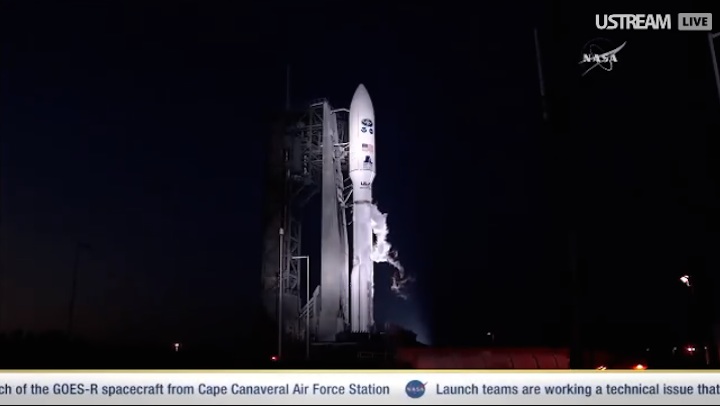

...
Update: 20.11.2016
Erfolgreicher Start von Atlas-V







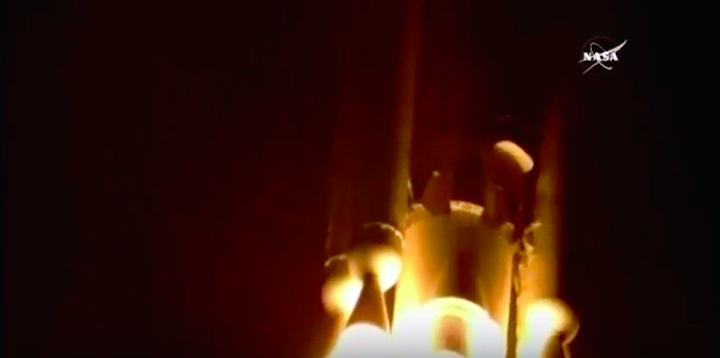



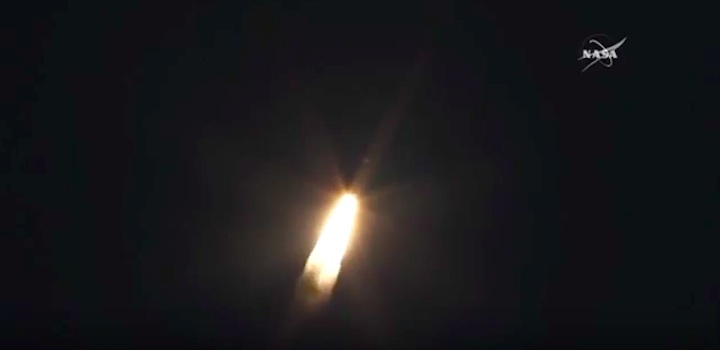





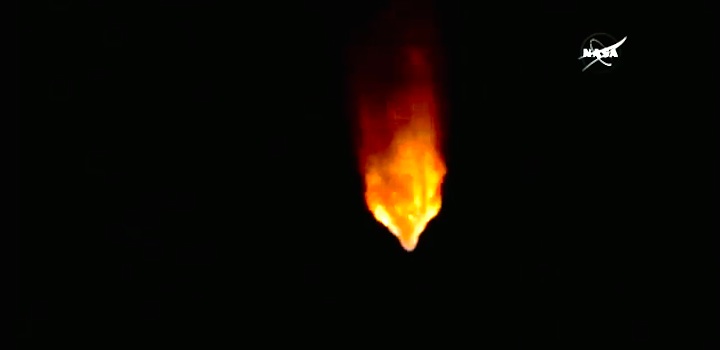











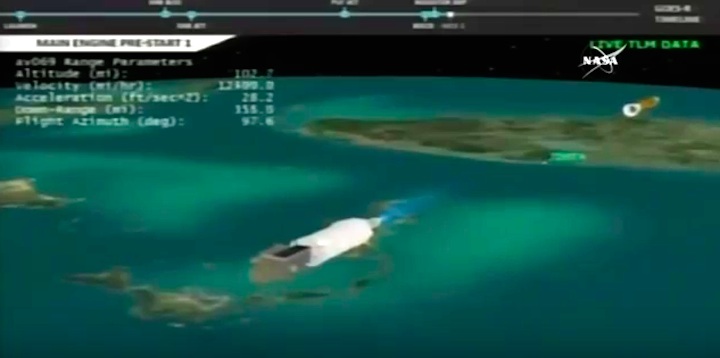

Quelle: ULA

